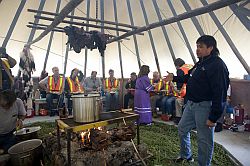 When Pic River First Nation Chief Roy Michano flew into Toronto to attend the 17th annual conference of the Canadian Aboriginal Minerals Association (CAMA) in November, he couldn't help being amused when his cab driver admitted to being of Indian ancestry. Though sharing the same ethnic label, they couldn't have been more different. Chief Michano's ancestors have called Ontario home for thousands of years. The cab driver, on the other hand, was a recent immigrant from South Asia.
When Pic River First Nation Chief Roy Michano flew into Toronto to attend the 17th annual conference of the Canadian Aboriginal Minerals Association (CAMA) in November, he couldn't help being amused when his cab driver admitted to being of Indian ancestry. Though sharing the same ethnic label, they couldn't have been more different. Chief Michano's ancestors have called Ontario home for thousands of years. The cab driver, on the other hand, was a recent immigrant from South Asia.
It's always a bit of a culture shock traveling from a remote First Nation community in Ontario's Far North and finding yourself hours later in the hustle and bustle of Canada's largest metropolis.
It can't be easy witnessing the economic divide between "newcomers" and their own people, but Chief Michano and other First Nation leaders attending the CAMA conference were focused more on the future than on the past.
Supreme Court
The November 16, 2006 decision by the Supreme Court of Canada affirming the government's duty to consult and accommodate First Nation communities for the use of their traditional territories has ushered in a new era of partnership and co-operation between mining companies and Aboriginal communities in Northern Ontario.Extensive news coverage of a standoff between junior miner Platinex Inc. and the Kitchenuhmaykoosib Inninuwug First Nation that resulted in the jailing of six member of the community in March 2008 may have created the impression that Ontario's Aboriginal people want nothing to do with mining, but the opposite is closer to the truth.
"We're not against resource development, but we want to make sure that our people benefit from it," Nishnawbe Aski Nation Grand Chief Stan Beardy told delegates at the CAMA conference.
Same wavelength
Based on interviews with mining companies and First Nation leaders for this Special Report on First Nation Engagement in the Mining Industry, the two sides are on the same wavelength. Exploration companies and global mining giants like Vale Inco, Xstrata Nickel, De Beers and Goldcorp are embracing the new reality. They're reaching out to First Nation communities, signing agreements, forming joint ventures and offering training, employment and business opportunities.Likewise, First Nation communities like Attawapiskat, Marten Falls, Webequie, Ginoogaming, Pic River and Kasabonika, to name a few, are supplying catering, claim staking, linecutting, diamond drilling and air services to junior mining companies. Some are staking claims and getting into the mineral exploration business themselves. Others are knocking on doors on Toronto's Bay Street to woo exploration companies to their traditional territory.
Keeping pace with this new reality, the Province of Ontario amended its Mining Act October 21 to incorporate Aboriginal consultation in mining legislation and regulations. It also introduced a dispute resolution process and awareness training for prospectors.
It's early going and there may still be bumps along the road, but for the most part, the budding relationship is a win-win proposition.
Shareholders benefit from certainty. Mining and exploration companies have a convenient source of labour. And First Nation communities are learning about and engaging with an industry that shares their attachment to the land and its resources.

